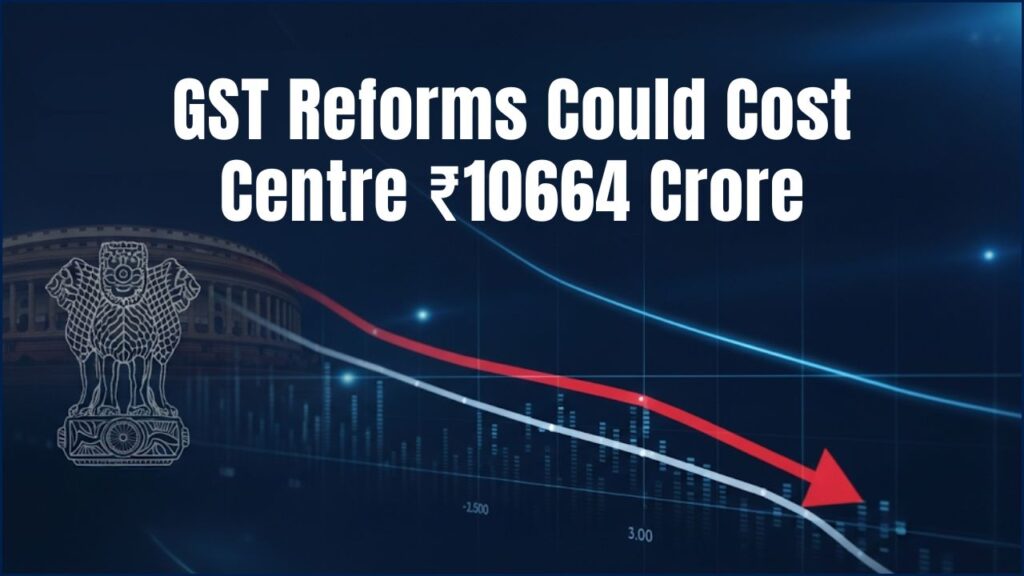
India’s recent GST reforms could cost the central government a net revenue shortfall of ₹10664 crore from import duties, according to a report by the Global Trade Research Initiative (GTRI). The shortfall is linked to changes in Integrated GST (IGST) collections following a restructuring of tax slabs on imported goods.
How the ₹10664 Crore Figure Emerged
The GTRI analysis suggests that imports worth $55.2 billion will see reduced GST rates, creating an estimated revenue loss of ₹49,324 crore. By contrast, imports worth $33.5 billion will face higher rates, generating an additional ₹38,660 crore. The net impact, however, is negative, leading to the projected ₹10,664 crore shortfall in IGST collections.
Integrated GST on imports accounts for nearly 24% of total GST revenue, amounting to about ₹5.33 trillion in FY 2024–25, highlighting the importance of this revenue stream.
Broader Fiscal Implications Beyond Imports
While the GTRI highlighted the import-linked revenue gap, the government has projected a wider fiscal implication of ₹48,000 crore annually due to the overall restructuring of GST slabs across goods and services.
Revenue Secretary Arvind Shrivastava clarified that the figure should be seen as a “revenue implication” rather than a direct loss, expressing confidence that improved compliance and consumer demand could offset much of the impact.
Differing Estimates from Analysts
Not all projections align with the GTRI findings. A report by the State Bank of India (SBI) suggested that the effective revenue loss may be closer to ₹3,700 crore in FY 2026, thanks to anticipated gains from higher consumption and tax compliance.
By contrast, UBS estimated that reforms could potentially result in an annual loss of up to ₹1.1 trillion, while Bank of America placed its forecast at a more moderate ₹48,000 crore, after factoring in higher “sin taxes” on luxury goods and non-essentials.
Context: Why the GST Reforms Matter
The latest restructuring reduces the number of tax slabs and attempts to simplify compliance for businesses. The two main slabs now stand at 5% and 18%, with certain luxury and non-essential products taxed at 40% under a special rate.
The government has framed these changes as part of a “GST 2.0” overhaul aimed at streamlining India’s indirect tax regime, boosting consumption, and supporting long-term growth.
However, experts warn that in the short term, the fiscal implications could complicate deficit management. According to Dr. Ajay Dua, former Secretary at the Ministry of Commerce and Industry, “Rate rationalisation is important for simplification, but the timing and execution must be calibrated to avoid revenue shocks.”
Economic and Political Stakes
The projected shortfall comes as the Centre works to meet its fiscal deficit target while balancing demands from states for higher revenue compensation.
With the Goods and Services Tax being one of India’s most significant reforms since independence, analysts note that the political stakes are high, particularly as states may seek adjustments if their revenues decline further.
Government Response and Future Outlook
Officials argue that the reforms are designed to increase efficiency and compliance in the long run, which could help balance short-term revenue losses.
Shrivastava emphasised, “It is not correct to call this a revenue loss. It is an implication of reforms. As the economy grows and consumption improves, the collections will stabilise.”
The government has signalled it will closely monitor collections in the coming quarters, with the possibility of further adjustments if fiscal risks rise.
Conclusion
The GTRI’s estimate of a ₹10664 crore IGST shortfall underscores the immediate fiscal challenges from GST reforms, while alternative projections show more varied outcomes. Whether the reforms prove a revenue strain or a catalyst for growth will depend on consumer response, compliance levels, and broader economic conditions.
















